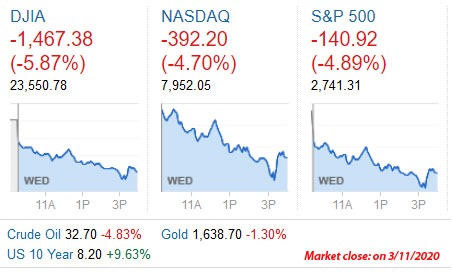Down, Down, Down the stock market goes on #COVID19 fears
Posted By RichC on March 11, 2020
Although I suspect all the selling on Wall Street has to do with needed cash or the “sell and re-assess later” attitude, I’ve been puzzled that gold (usual safe haven) and utilities have been hit as well. Personally I thought these areas might balance exposure to industrials, tech and energy. Obviously not as Wednesday’s market close was again very ugly.
Still, I do think that if we truly are going to experience a longer term bear market or possible recession that utilities with their fixed cost and attractive dividends based on steadily supplying the electric, gas and water everyone uses should be ok???
What is the utilities sector?
It includes electric, gas and water utilities; independent power producers and energy traders; and companies that produce electricity using renewable sources.
The Utilities sector has tended to perform better when growth and trade concerns resurface, and to underperform when those concerns fade. That’s partly because of the sector’s traditional defensive nature—people need water, gas and electric services during all phases of the business cycle—and these are domestic goods and services, so it has very little international exposure. That suggests that signs of weakness in the global economy amid coronavirus (COVID-19) epidemic concerns could relatively support the sector.
Additionally, Utilities stocks are among the most positively affected by falling interest rates, as investors seek higher yields and because the sector has high fixed costs and relatively high debt ratios. The sector has experienced good momentum relative to the other sectors—both on a short- and long-term basis—which could continue if interest rates continue to fall.
While defensiveness can be attractive in uncertain times, we are concerned about valuations, which have risen to well above historical levels both on an absolute basis and relative to the other sectors.
Sector Overview: Utilities
Note: Each of the sector lenses shown above—Macroeconomic, Value, Fundamental and Relative Strength—is both intuitive and evidenced-based in nature. Within each, there are a varying number of factors. The Macroeconomic lens includes sector sensitivities to interest rates, stocks and the value of the U.S. dollar; the outlook for each of these is determined by the Schwab Center for Financial Research (SCFR)’s Asset Allocation Working Group, which uses a mosaic approach of quantitative and qualitative considerations. Value includes six different valuation metrics that provide a holistic perspective on current valuations relative to each of the sectors’ own historical valuations, as well as relative to the other sectors. Fundamental provides insight as to how efficiently the companies within each sector use invested capital to produce earnings; this historically has been informative as to future relative performance of the sectors. Finally, Relative Strength measures momentum of the individual sectors against all of the other sectors. We also consider the data in the context of factors outside the scope of these indicators—for example, geopolitical risk or central bank policy changes.
Source: Charles Schwab, as of 03/05/2020.


Comments